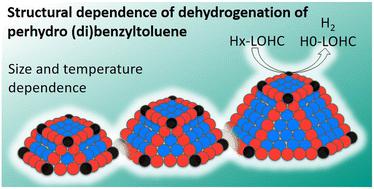当前位置:
X-MOL 学术
›
Catal. Sci. Technol.
›
论文详情
Our official English website, www.x-mol.net, welcomes your feedback! (Note: you will need to create a separate account there.)
Structure sensitivity of the low-temperature dehydrogenation of perhydro dibenzyltoluene on supported platinum nanoparticles
Catalysis Science & Technology ( IF 4.4 ) Pub Date : 2024-08-01 , DOI: 10.1039/d4cy00032c Yazan Mahayni 1, 2 , Lukas Maurer 1, 2 , Franziska Auer 1 , Andreas Hutzler 1 , Peter Wasserscheid 1, 2 , Moritz Wolf 3
Catalysis Science & Technology ( IF 4.4 ) Pub Date : 2024-08-01 , DOI: 10.1039/d4cy00032c Yazan Mahayni 1, 2 , Lukas Maurer 1, 2 , Franziska Auer 1 , Andreas Hutzler 1 , Peter Wasserscheid 1, 2 , Moritz Wolf 3
Affiliation

|
In this study, the structure sensitivity of the dehydrogenation reactions of the commonly used liquid organic hydrogen carrier (LOHC) molecules perhydro dibenzyltoluene (H18-DBT) and perhydro benzyltoluene (H12-BT) is investigated. We focus on the hydrogen release at moderate reaction temperatures, which is particularly relevant to enable heat integration of the LOHC dehydrogenation process with, for example, high-temperature fuel cells for an enhanced overall efficiency. To determine the most suitable platinum nanoparticle size with the highest surface specific productivity, a colloidal approach was used for the synthesis of Pt/Al2O3 catalysts with well-defined nanoparticle sizes. These catalysts were used in the dehydrogenation reactions of H18-DBT and H12-BT in the temperature ranges of 250–280 °C and 220–240 °C, respectively. A structure sensitivity was identified in both cases, which becomes particularly prominent at lower reaction temperatures. This is attributed to the overall slower reaction kinetics and the amplified differences of the adsorption strength on different surface sites. A maximum in surface specific productivity was found for catalysts with a Pt nanoparticle size of 2.6 nm for H18-DBT and 2.3 nm for H12-BT dehydrogenation. It is assumed that the observed structure sensitivity is mainly due to an optimal surface composition of the nanoparticles with an ideal balance between strongly adsorbing corner and edge sites and less active terrace sites. At low temperatures, desorption from low coordinated sites is limiting for nanoparticles below 2.3 nm, while the increasing share of terrace sites in nanoparticles larger than 2.7 nm reduces the overall productivity of the catalyst due to their lower specific activity. This behavior becomes less pronounced at higher temperatures. The dehydrogenation of H12-BT was even shown to be rather structure insensitive at 240 °C.
中文翻译:

负载铂纳米颗粒上全氢二苄基甲苯低温脱氢的结构敏感性
在本研究中,研究了常用的液态有机氢载体(LOHC)分子全氢二苄基甲苯(H18-DBT)和全氢苄基甲苯(H12-BT)的脱氢反应的结构敏感性。我们专注于中等反应温度下的氢气释放,这对于实现 LOHC 脱氢过程与高温燃料电池等的热集成特别相关,以提高整体效率。为了确定具有最高表面比生产率的最合适的铂纳米颗粒尺寸,采用胶体方法合成具有明确纳米颗粒尺寸的Pt/Al 2 O 3催化剂。这些催化剂分别用于H18-DBT和H12-BT在250-280℃和220-240℃温度范围内的脱氢反应。在这两种情况下都发现了结构敏感性,这在较低的反应温度下变得尤为突出。这归因于整体反应动力学较慢以及不同表面位点吸附强度差异的放大。对于 H18-DBT 的 Pt 纳米颗粒尺寸为 2.6 nm,对于 H12-BT 脱氢,发现 Pt 纳米颗粒尺寸为 2.3 nm 的催化剂具有最大的表面比生产率。假设观察到的结构敏感性主要是由于纳米颗粒的最佳表面组成,以及强吸附角和边缘位点与活性较低的平台位点之间的理想平衡。在低温下,对于 2.3 nm 以下的纳米颗粒,低配位位点的解吸受到限制,而大于 2 nm 的纳米颗粒中梯田位点的比例不断增加。7 nm 由于其较低的比活性而降低了催化剂的整体生产率。这种行为在较高温度下变得不那么明显。 H12-BT 的脱氢甚至被证明在 240 °C 时对结构相当不敏感。
更新日期:2024-08-01
中文翻译:

负载铂纳米颗粒上全氢二苄基甲苯低温脱氢的结构敏感性
在本研究中,研究了常用的液态有机氢载体(LOHC)分子全氢二苄基甲苯(H18-DBT)和全氢苄基甲苯(H12-BT)的脱氢反应的结构敏感性。我们专注于中等反应温度下的氢气释放,这对于实现 LOHC 脱氢过程与高温燃料电池等的热集成特别相关,以提高整体效率。为了确定具有最高表面比生产率的最合适的铂纳米颗粒尺寸,采用胶体方法合成具有明确纳米颗粒尺寸的Pt/Al 2 O 3催化剂。这些催化剂分别用于H18-DBT和H12-BT在250-280℃和220-240℃温度范围内的脱氢反应。在这两种情况下都发现了结构敏感性,这在较低的反应温度下变得尤为突出。这归因于整体反应动力学较慢以及不同表面位点吸附强度差异的放大。对于 H18-DBT 的 Pt 纳米颗粒尺寸为 2.6 nm,对于 H12-BT 脱氢,发现 Pt 纳米颗粒尺寸为 2.3 nm 的催化剂具有最大的表面比生产率。假设观察到的结构敏感性主要是由于纳米颗粒的最佳表面组成,以及强吸附角和边缘位点与活性较低的平台位点之间的理想平衡。在低温下,对于 2.3 nm 以下的纳米颗粒,低配位位点的解吸受到限制,而大于 2 nm 的纳米颗粒中梯田位点的比例不断增加。7 nm 由于其较低的比活性而降低了催化剂的整体生产率。这种行为在较高温度下变得不那么明显。 H12-BT 的脱氢甚至被证明在 240 °C 时对结构相当不敏感。





































 京公网安备 11010802027423号
京公网安备 11010802027423号